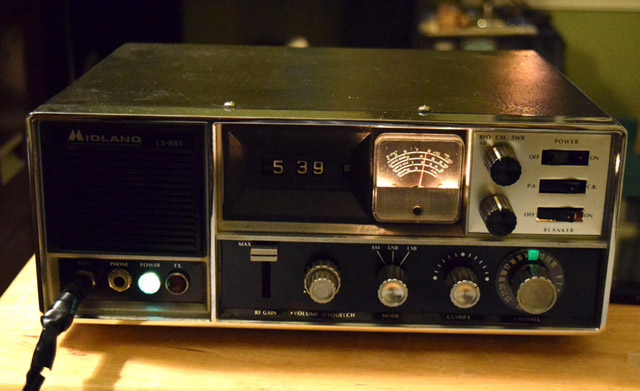

This is the Midland model 13-885. This was Midland's top of the line SSB/AM base station at the time it was manufactured in the early 1970's. This radio featured a Volume, Squelch, R.F. Gain, a synchronized transmit/receive clarifier, switchable Noise Blanker, and a clock (Display only). Other positive features included the very large and somewhat linear "S"/RF-meter, with built-in SWR bridge. On the minus side, the receiver's adjacent channel rejection was not the greatest, and suffered from strong signal overloading, even after the addition of tighter I.F. filters. One big help was to not use the noise blanker which, when turned on, made the bleed over problem worse, especially on SSB.
The pictured radio was manufactured in 1971, and was my first SSB base station which I obtained in the spring of 1976. This radio had seen several owners before it found its way into my hands, including Steve (who owned it in 1973), Blue Bandit, and then Channel Master, who was in possession of it when it was the victim of an unfortunate lightning strike. I ended up with it as a horse trade for my Radio Shack TRC-47, after the Midland had been fried by the lightning strike. It had suffered from burned out audio transistors, and a power supply regulator, which turned out to be easy to fix. Once fully restored, I would then use this radio as my primary base radio from early 1976, until about 1980. In 1977, I modified it by adding extra crystals, in order to cover the expanded channels for full 40 channel coverage (Plus a few more). The clarifier was also modified to give a -10Khz drop. One of the best features of this radio was transmit audio. This radio had plenty of microphone gain, making a pre-amplified mic almost superfluous. When I originally got the radio, it was equipped with a Turner +2 desk mike. I wired my Astatic D-104 to it as well. A Shure 444 desk mike also saw some use, when I lent the radio to my father-in-law in the mid 80's. With a mic like a D-104, this radio was known to splatter a few channels. Even with the un-amplified Shure 444, it was still loud.
I would rate this radio as a 5 on a scale of 1 to 10. The receiver selectivity issues did not limit my use all that much, and it provided me a test bed for technical experiments for a long while.
Today this radio is part of my vintage radio collection. I recently went over it and replaced the defective clock, a sticking S-meter, and a bad RF Gain pot with parts scavenged from a donor parts radio, and gave it a tune-up. For a 50 year old radio, it works pretty well.